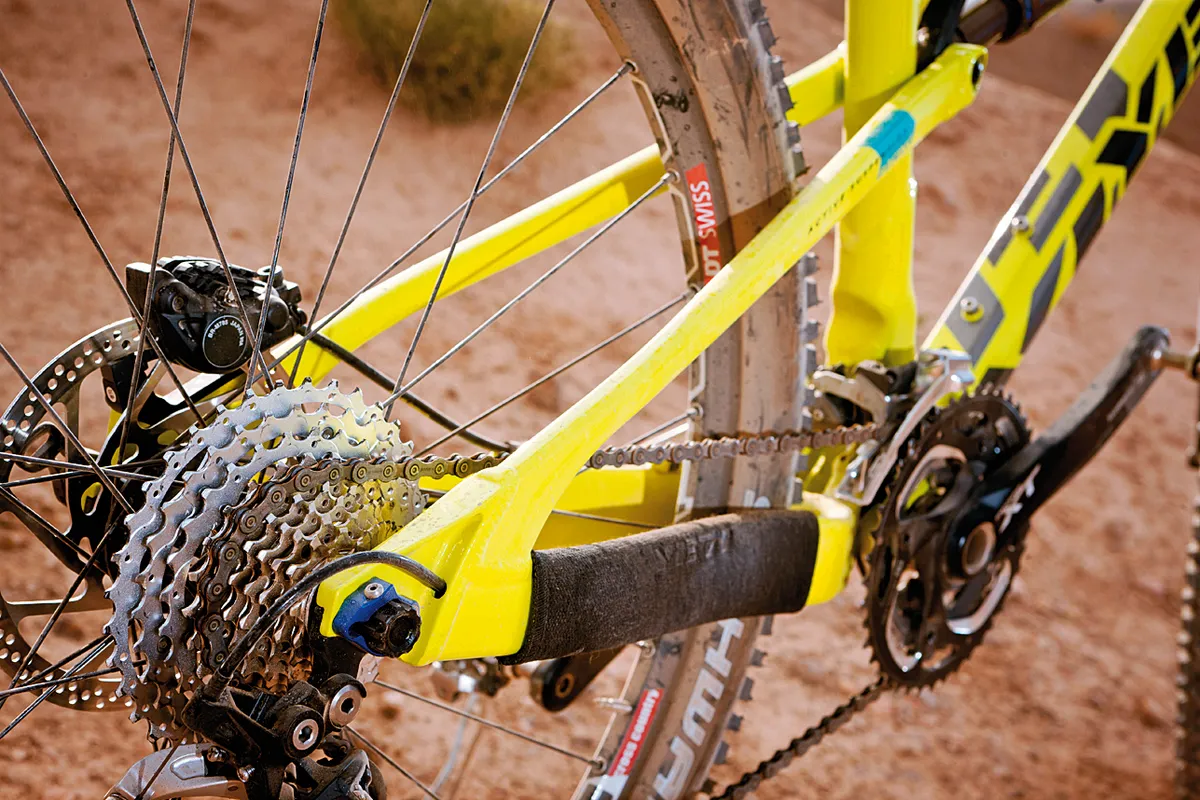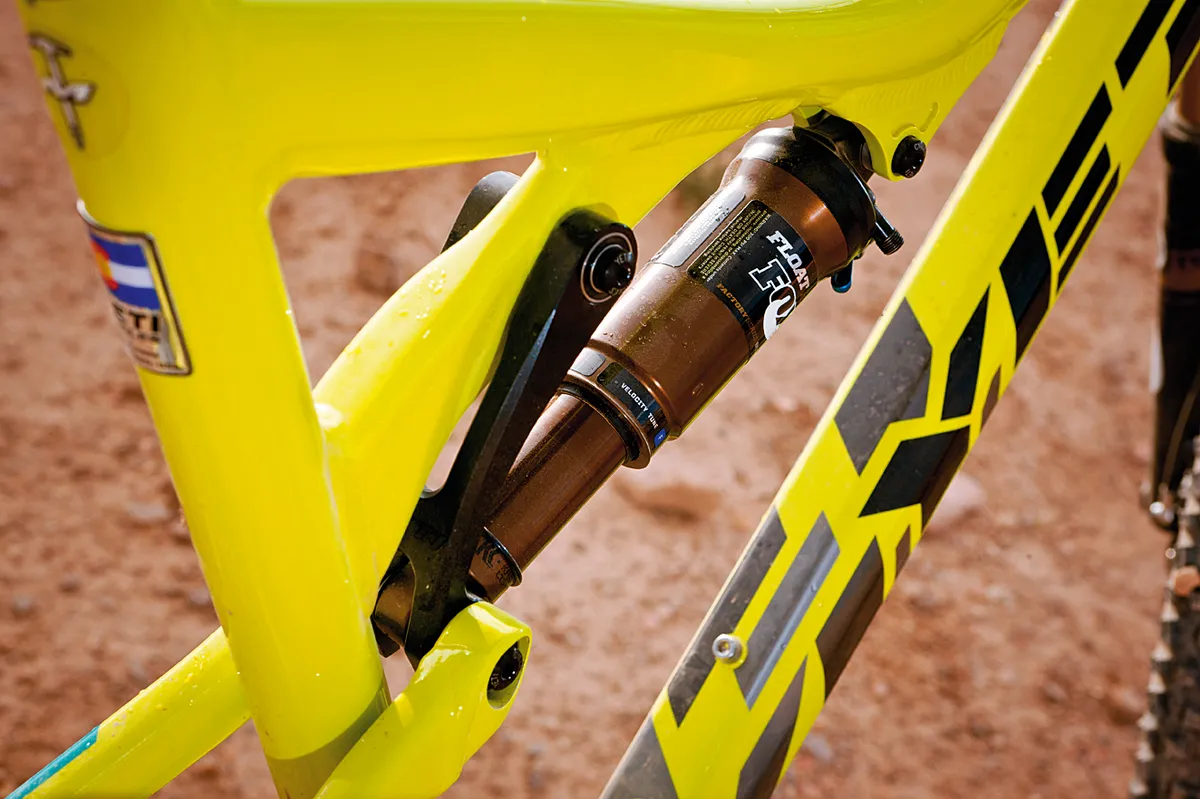Yeti’s eponymous 5.75in-travel 575 all-rounder first appeared in 2004, making it one of the first truly lightweight 140mm (146mm to be exact) trail bikes. Since then a series of evolutions has kept it an extremely popular aspirational all-rounder and the 2012 refresh continues that story at a more affordable price.
Yeti’s 2012 reworking adds useful frame stiffness, more mud clearance and a smoother shock. Sensitive suspension action makes it better suited to fast red routes or natural trail riders than black runs but this sweet handling, super-smooth classic is more of a bargain than ever before.
Ride & handling: Smooth and fast flowing
With a generous, almost 24in, top tube on the medium size frame there’s no sense of being cramped. Unlike some 6in bikes you don’t have to stick your knees out sideways to avoid clobbering the bars if you stand up when climbing. Like most Yetis, while it’s mid weight rather than particularly light in frame or complete bike terms it loves to gain altitude.
The lack of seatstay brace doesn’t seem to be an issue in twist terms, with the screw-thru axle keeping things in line when you’re grinding the pedals. The big chainstays mean minimal drive dilution between your legs and the trail. The active suspension can add smooth, terrain tracking traction too, although getting the rebound right is essential to stop it kicking up over small bumps when you’re giving it the beans.
Getting the right air pressure/sag is important too, but the custom tuned damper means pedal related bob’s less of a problem than we expected, even with the ProPedal compression control off. The fluid, but not overly bouncy, Kashima coated action means you can stay in the saddle and spin smoothly over more rugged trails than most bikes can manage. Add generous breathing space built into the frame and as long as you’re careful about the fairly low bottom bracket/crank clearance it’s a great ally on technical climbs of any length.
While they started out disturbingly flexy through the mid section, 575s have got stiffer with every iteration and the new 2012 bike is no exception. It’s not über stiff, but tracking from 15mm front to 12mm rear axle is accurate enough for tight line control and precision steering. Easy sag at the rear tips the already steady head angle back further and combines with the low bottom bracket to add extra stability when you’re really tanking. Jam your outside foot down, drop your shoulder and look through the apex and it’ll fly round curving berms and long loose corners alike with superb foot up confidence.
That said we can see a lot of UK Yetis getting a shorter (say 70mm) stem for more twitchy steering reactions and faster responses to lost traction on wet roots and rocks in typically slower British riding speeds. Noticeable hang-up over flat faced, square edged bumps and a habit of rushing through the travel without adding extra control mean it’s less big-hit capable and chaos controlled than other 6in travel options, so look elsewhere for real lunacy.

Frame: Stiffer with more mud clearance
The ‘milk bottle’ head tube is now upsized to tuck the tapered headset bearings inside rather than out, otherwise it’s the same really big ‘humpbacked’ multifaceted top tube dipping away towards a shock mount/standover clearance bend. A small seat tube bridge piece carries the backswept swing link with mounts for a dropper post cable fitted.
External clips carry the gear and brake controls down the underside of the slim (compared to the top tube) down tube, with ample room for a conventional bottle cage mount. The lower seat tube section is notched, shaped and dog legged up and back to allow clearance for the swingarm-mounted front mech. The main pivot stays tucked in above the conventional external cup bottom bracket and the ISCG mounts, and big rectangular chainstays added at the last revision carry through.
It’s still IS (International Standard) rather than post in brake mounting terms, but Yeti were already ahead of the curve with optional ‘chips’ for 142x12mm screw-through axles or quick-release hubs on previous bikes. The significant change (in price and practicality terms) is that the big triangular dropouts now weld onto slim, centre tapered alloy seatstays not a one-piece carbon stay assembly.
The principle of using slight engineered frame flex rather than a full rear pivot remains, but using hydroformed alloy saves a lot of money without adding much weight. The other big benefit is that the curved drop down, mud scooping brace of the carbon bike – or any other sort of brace – disappears, leaving a more open, filth friendly rear.
Equipment: Four complete bike options available
While a lot of Yetis will be built up from bare frames with parts sweated over, there are also four complete bike options. The cheapest Enduro option is a mid-level SRAM X7/9 transmission, with Truvativ cockpit and seatpost, and DT Swiss wheelset with quick-release rear at £2,700.
There’s the Race version in either Shimano XT (tested here) or SRAM X9/X0 guise plus a full Shimano XTR ‘Pro’ option that’s likely to be a long way past £5,000 when pricing is confirmed. It’s worth noting that all the complete bikes get a top-spec Fox F150 FIT RLC 15mm Kashima coated, tapered-top fork and matching Kashima rear shock.

This article was originally published in What Mountain Bike magazine.



